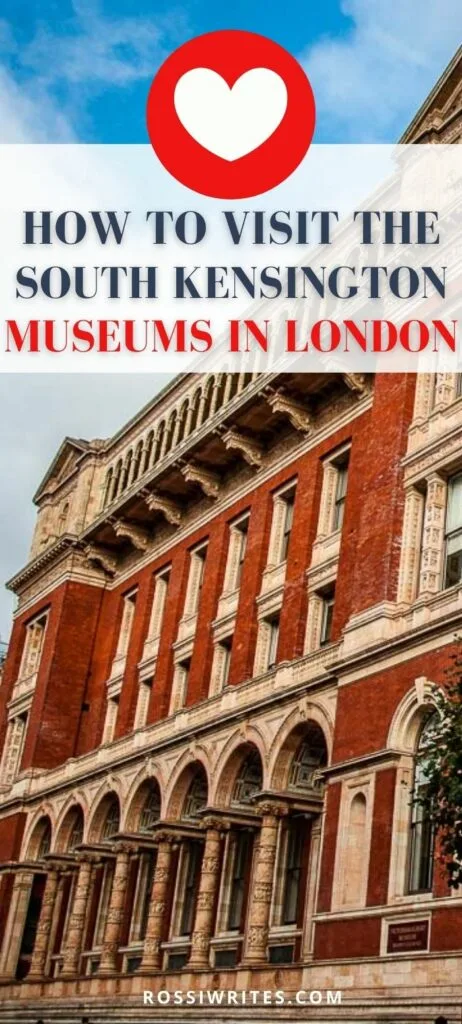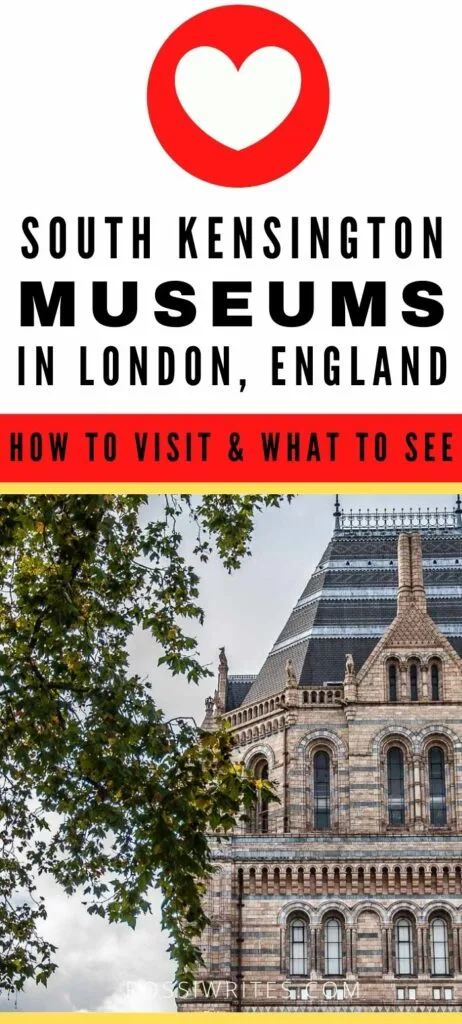Three world-famous museums stand right next to one another in the heart of the upmarket London district of South Kensington.
Collectively known as the South Kensington Museums, individually they are the Natural History Museum, the Science Museum, and the V&A Museum. Here is how to visit them during your stay in the British capital.
You will find the South Kensington Museums a stone’s throw away from a number of iconic London landmarks like Royal Albert Hall, Hyde Park, Harrods, and Kensington Palace. All three have expansive collections covering a wide array of human creativity and knowledge. The best of all is that these three prestigious and exciting museums are generally free to visit!
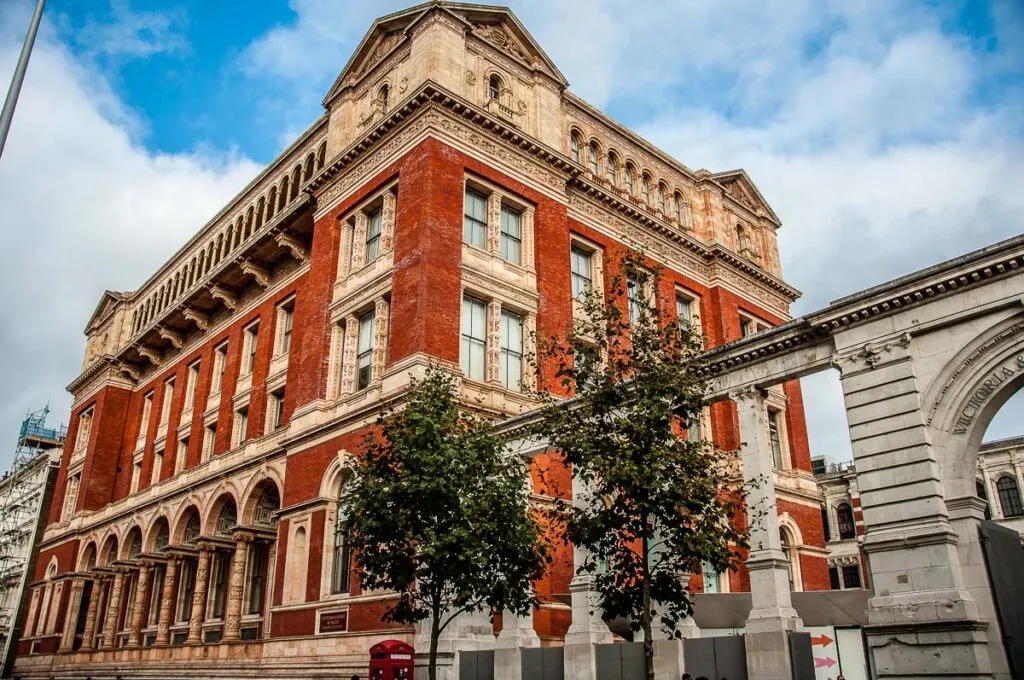
If you are spending a few days in London as a tourist, the South Kensington Museums are a must-see. And if you live in the British capital, these three museums are a great destination to revisit on those days when you feel like learning new things, when you need to keep the kids entertained, and even when you simply want to have a coffee and a light bite to eat in close proximity to natural wonders and sublime works of art.
The three museums in South Kensington were among the first sights that I ticked off when I moved to London from Bulgaria back in December 2000. Since those initial moments spent in their breathtaking galleries and halls, I have been returning to revisit them any chance I got. To the point that the Natural History Museum was where one of my first dates with my now husband took place (the Dinosaurs Gallery can be an unexpectedly good place for a date!). And I wouldn’t miss the temporary exhibitions at the V&A Museum for the world. A personal favourite of mine was the one dedicated to Annie Lennox – once a lead singer of the legendary Eurythmics – back in the distant 2011.
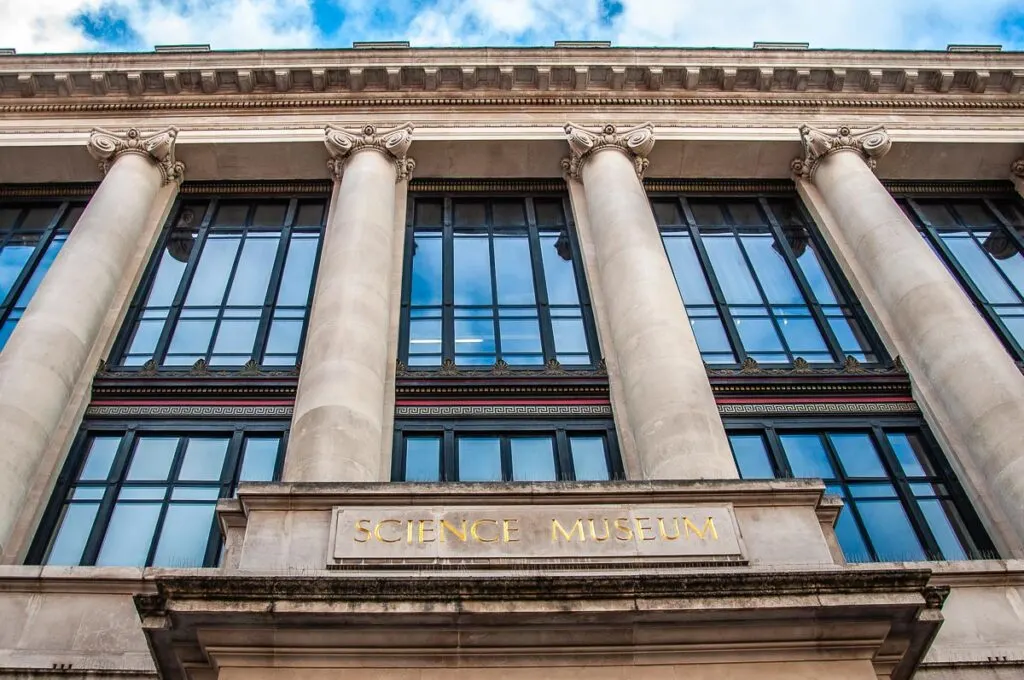
Now, that I, once again, live in England after six years in Italy, I am in the process of happily revisiting old London favourites. The South Kensington Museums were top on my list and so far, I have ticked them off about half a dozen times.
So, in case you want to see these three London landmarks for yourself, in this blog post today, I share with you lots of practical tips about ticking them off your list. From how to get to the South Kensington Museums to how to best experience their collections and highlights, expect lots of useful information to make the most of your time. I hope that the details shared herewith will galvanise you to head to the monumental buildings of the three museums as soon as possible.
Have a look!
South Kensington Museums in London, England – How to Visit and What to See
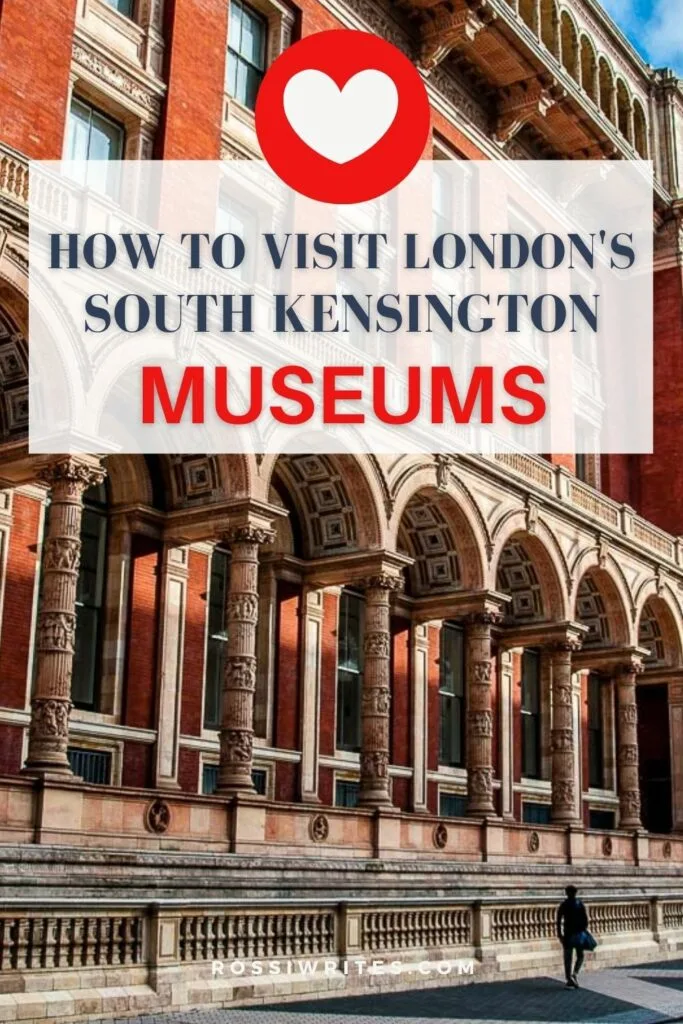
What Are the South Kensington Museums in London, England?

First things first! What are the South Kensington Museums and why it is so important to see them when in London, England?! In a nutshell, these are three large and exciting museums dedicated to different branches of human knowledge and creativity:
- Natural History Museum – with over 80 million objects (and counting!), it houses the world’s most important natural history collection. Its roots go back to 1753 and it moved to its current, specially built building in 1881. From dinosaurs to earthquakes and from meteorites to mammals, the natural world is your oyster on a visit to this spectacular museum.
- Science Museum – founded in 1857, this is a museum that gives you a detailed introduction to many different branches of the sciences and makes you want to learn more. From medicine and mathematics to space travel and flight simulators, it covers a wide scientific and technological range. The museum occupies an imposing building that was opened to the public in stages between 1919 and 1928. In the decades that followed several annexes were added to it.
- V&A Museum – founded in 1852 and billed the world’s leading museum of art and design, it occupies a spectacular series of buildings that are an impressive mix of an Ancient-Greek temple, a Gothic cathedral, and an Italian Renaissance palace. Originally known as the Museum of Ornamental Art and later as Victoria & Albert Museum, it showcases the creative pinnacles of cultures from all around the world. Plus, it has what must be London’s most beautiful cafe where you are surrounded by stained glass, ceramic pillars, and life harp music as you sip your coffee.
Housed in monumental, specially built buildings, the three South Kensington Museums have been setting standards for many decades. They are among the most well-known and prestigious museums in the UK and the world. They have extraordinary collections of original artefacts, widely respected research programmes, and a rich calendar of temporary exhibitions and special events.
What Are the Best Things to See in the South Kensington Museums in London, England?
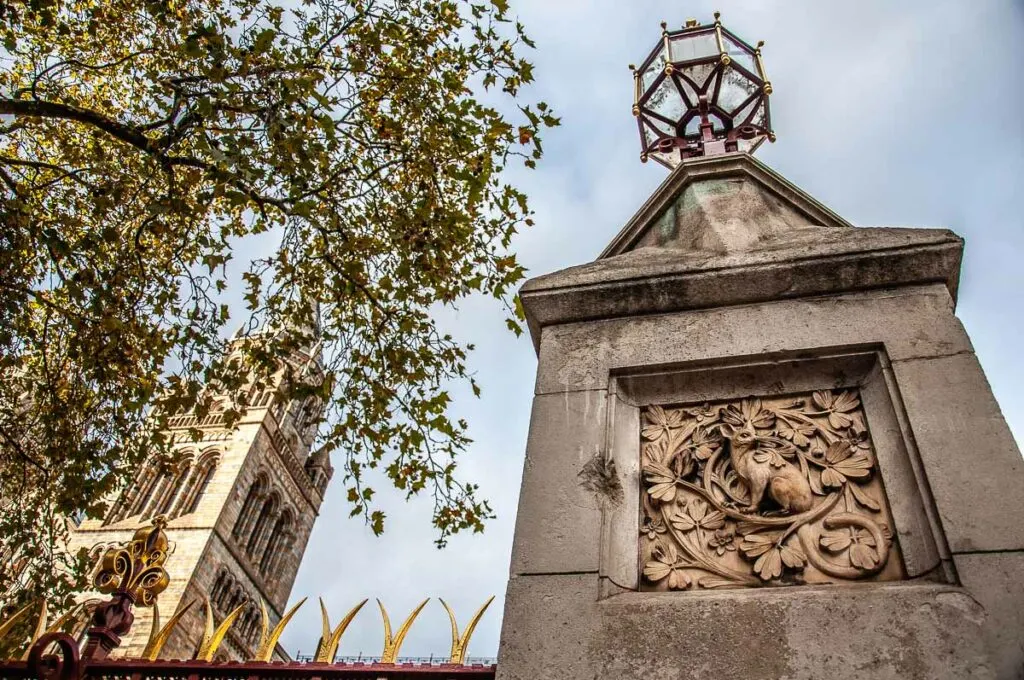
There are many wonderful exhibits and collections to see in the South Kensington Museums in London, England. From dinosaurs to dynastic artefacts, from precious prints to primates, the museums cover many different branches of the sciences and the humanities.
Here are some of my favourite highlights that, I hope, would appeal to you, too:
Natural History Museum
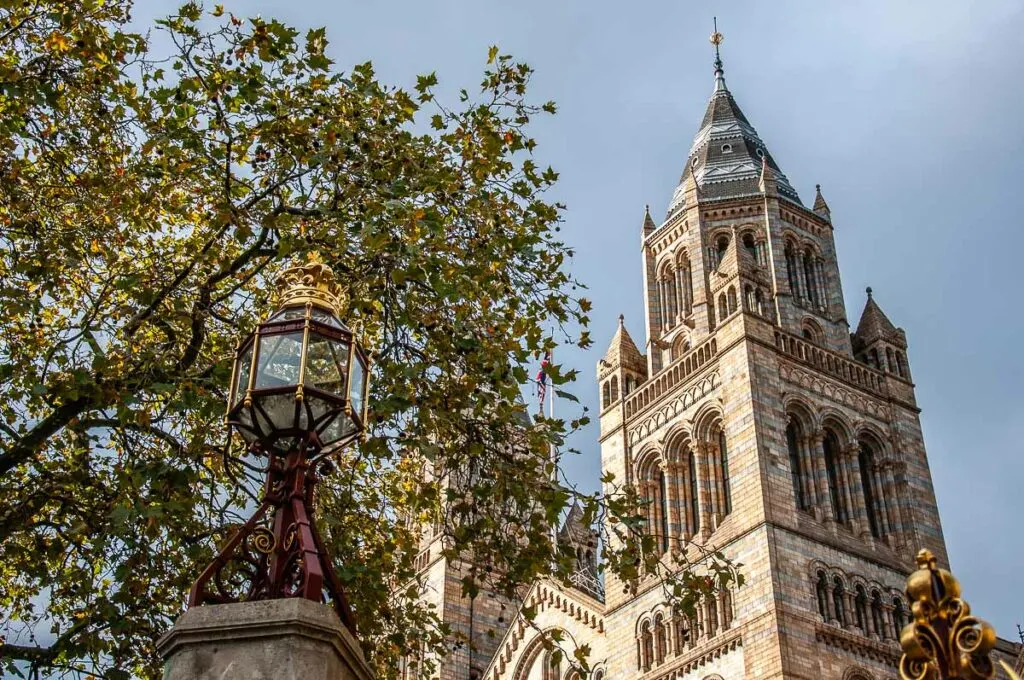
The Natural History Museum is organised into four different colour-coded zones – Orange, Blue, Green, and Red. In a nutshell, the Orange Zone is where you will find the Darwin Centre, the Cocoon, and the Wildlife Garden with over 3,300 plant and animal species. The Blue Zone is dedicated to the diversity of life and has large exhibits dedicated to dinosaurs, amphibians, mammals, reptiles, and marine invertebrates. The Green Zone explores the evolution of the planet and centres on birds, insects, fossils, and minerals. The Red Zone is all about the changing history of Earth from human evolution to seismology and volcanology.
I particularly like the Dinosaurs Gallery, the Earth Hall with its amazing escalator, and the earthquake simulator in the Volcanoes and Earthquakes Gallery.
Among the rarities and curiosities that the Natural History Museum in London owns stand out the first edition of Darwin’s On The Origin of Species, the around 4,6 billion years old Wold Cottage Meteorite which fell in Yorkshire in 1795, a dodo skeleton, and even a moon rock. By clicking here you can see what other treasures the museum holds.
The actual building of the Natural History Museum is also truly impressive. It opened its doors in 1881 and it was purposefully built to house the museum. Its architecture and ornamentation are worth a detailed look. The Hintze Hall – the gateway to the museum’s collections – is particularly stunning.
Science Museum
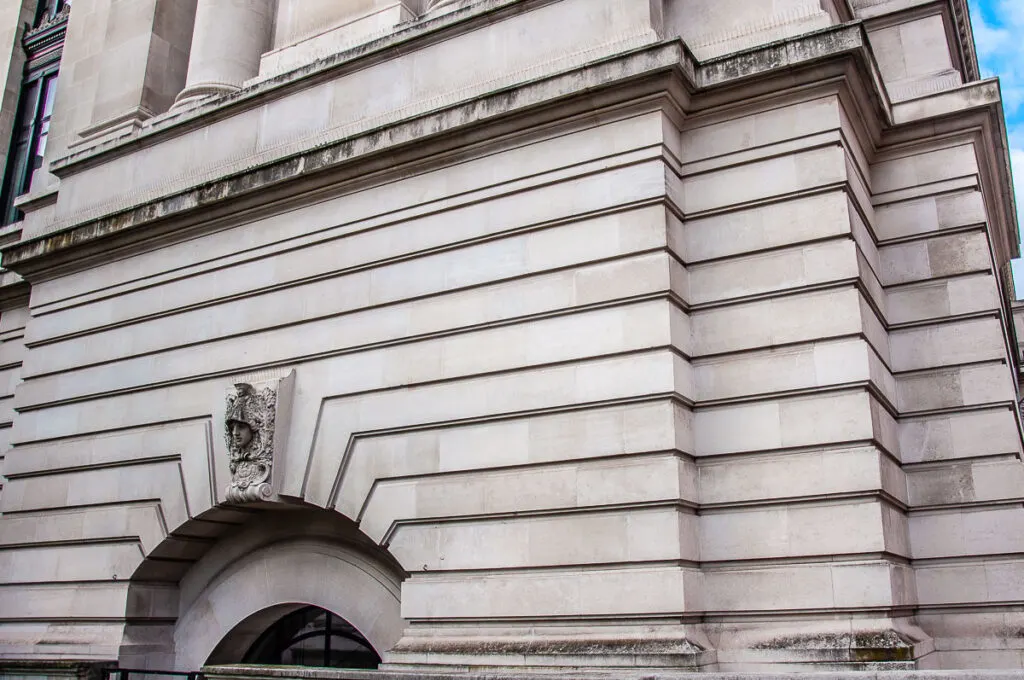
The Science Museum has two buildings – the main building (with five levels – from -1 to 3) and the Wellcome Wing (with four levels – from 0 to 3).
In the main building, I particularly like the steam engines in the Energy Hall and the space rockets on Level 0, the Clockmakers’ Museum (the world’s oldest of its type) and the Linbury Gallery (exploring the development of the sciences in London from 1550 to 1800) on Level 2, and the Flight Gallery on Level 3 where you can see old planes and helicopters and find out about the history of flight. There are many more collections and hubs here covering different branches of the sciences.
The Wellcome Galleries in the Wellcome Wings contain the most significant medical collections in the world. Come to see over 3,000 medical artefacts that trace the history of medicine over the past 500 years.
V&A Museum
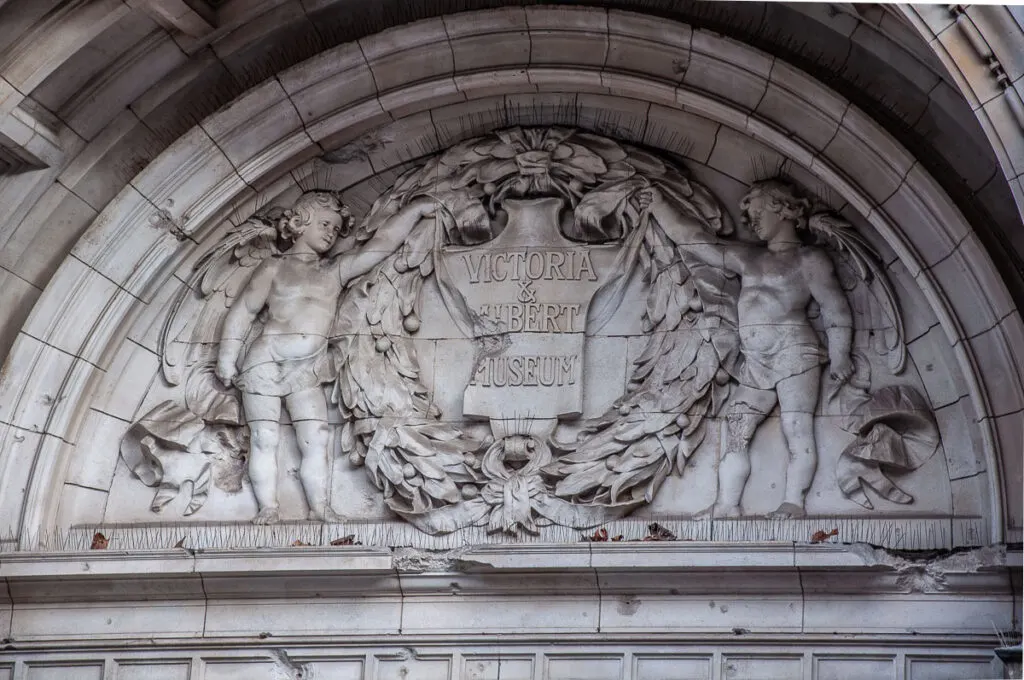
The V&A Museum has 145 galleries and it occupies 12.5 acres of land. It is a huge museum with levels that start from -1 and go up to 4. From sculptures and jewellery to fashion and furniture, its spacious halls have artefacts that trace the creative expression of humanity over the past 5,000 years.
It is a museum that is eclectic, difficult to summarise, and where new discoveries await you at every step. In general, there are six thematic departments: (1) Asia; (2) Furniture, Textiles, and Fashion; (3) Sculpture, Metalwork, Ceramics, and Glass; (4) Word and Image; (5) Theatre and Performance. For the sixth department of the V&A Museum, see the note at the end of this section.
Altogether, more than 6.5 million objects are preserved in the V&A Museum in London. You can explore many of the museum’s highlights at this link. Manuscripts (including Leonardo da Vinci’s notebooks), glass, the Glastonbury Festival archive, even wallpaper… The collections held here are eclectic, priceless, and open new worlds in front of you. For me, two of the most precious and unmissable things to see here are:
- The Raphael Cartoons – seven full-scale designs for tapestries painted by the eminient Italian Renaissance artist Raphael.
- The Cast Courts – a breathtaking collection of plaster casts and reproductions of some of the world’s most significant works of art. Not everyone may have a chance to see them all in person at the exact places around the world where they are kept nowadays, so being able to see their copies side by side in the V&A Museum in London is quite the experience.
Above all, the actual buildings of the V&A Museum are the absolute star of this London landmark. From the grand entrance and the Rotunda chandelier to the ceramic staircase and the John Madejski garden with its oval shallow pool, you can spend almost as much time taking in the architecture and the decor of the V&A Museum as exploring its incredible collections.
N.B.: The sixth department of the V&A Museum is dedicated to childhood toys and games and used to operate as the Museum of Childhood in its own building in Bethnal Green in London. This museum is currently being completely overhauled and its name will change to Young V&A when it opens its doors again.
How Much Does it Cost to Visit the South Kensington Museums in London, England?
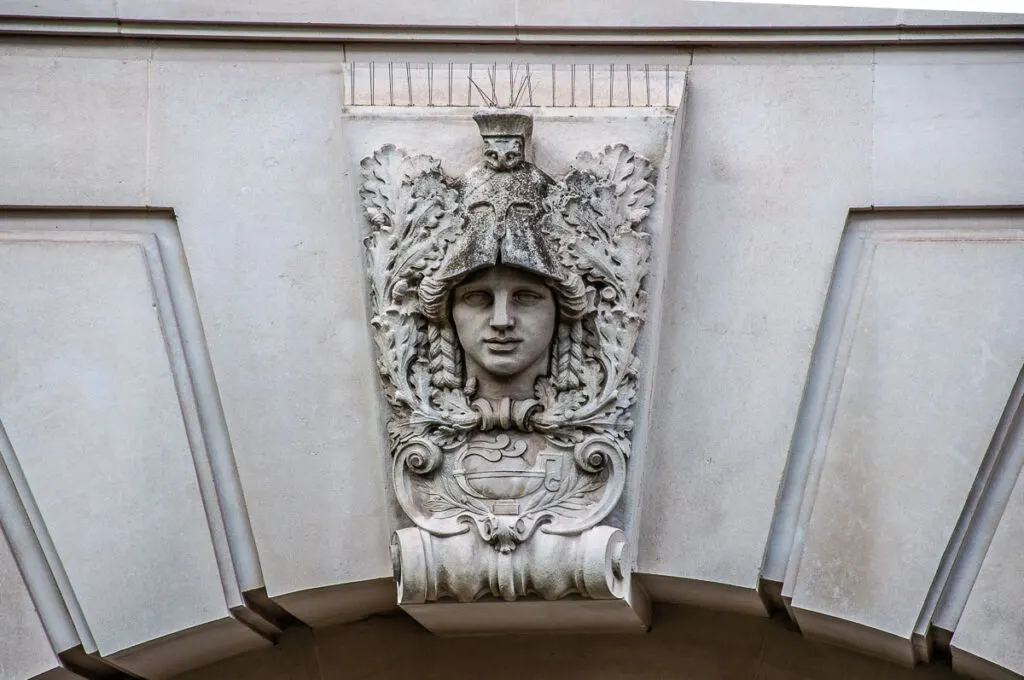
The best thing about the South Kensington Museums in London is that they don’t charge an entrance fee for their permanent exhibitions. The Natural History Museum, the Science Museum, and the V&A Museum are government-sponsored and have been offering free admission since 2001. This combined with their extraordinary collections results in an ever-growing number of visitors.
Bear in mind that specialised temporary exhibitions held at the South Kensington Museums are customarily paid for. You can still visit the permanent collections of the museums for free in the meantime.
Also, the Science Museum charges a fee for several of its experiences. For example, Wonderlab: The Equinor Gallery, IMAX Cinema, and Fly 360° simulator.
Can I See All Three South Kensington Museums in a Day?
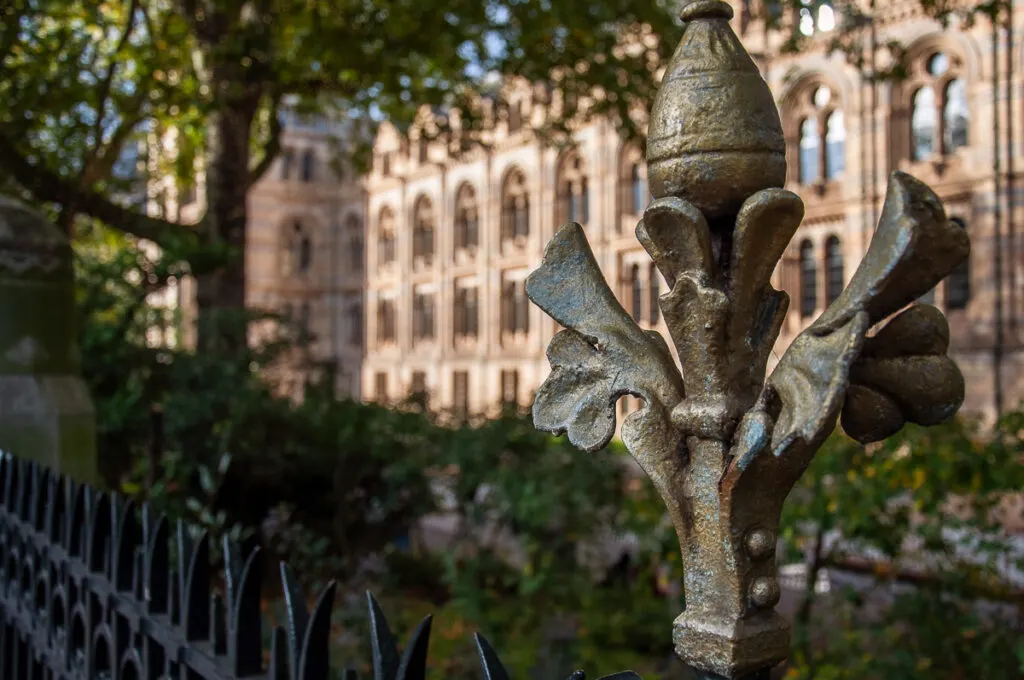
The shortest answer to this question is ‘Yes and no!’.
Yes, as the three South Kensington Museums are less than a minute away from one another. So, you can easily walk between them and as soon as you are done with one, you can head to the next museum on your list.
No, if you expect to see absolutely everything in each of the three museums. For this, you will easily need weeks if not months.
What to do then?! Your options depend on the length of your stay in London.
If you are in the British capital for a limited amount of time and you can dedicate only a day to the South Kensington Museums, then make the day count. If you want to see all three museums, then come up with a strict schedule and stick to it. For example, two hours at the Natural History Museum, two hours at the Science Museum, and the rest of the time at the V&A.
In this case, have a look at the museums’ websites in advance, consult their respective floor plans (NHM, SM, and V&A), and pick the collections you are most interested in. These could be the Dinosaurs Gallery, the Earthquake simulator, and the Earth Hall in the Natural History Museum. Followed by the Flight Gallery and the Exploring Space Gallery in the Science Museum. To then round it off with a visit to the Medieval & Renaissance Gallery and the Jewellery Collections at the V&A. It’s your choice!
Make sure that you book your free timed entry in advance for all three South Kensington Museums. The official links are Natural History Museum, Science Museum, and V&A Museum. Booking your visit will allow you to access the museums on a specific day and at a specific time. This is very helpful if you are adhering to a strict schedule.
If you prefer, you can also book a private guided tour of the Natural History Museum. This will guarantee you a skip-the-line entrance and the undivided attention of a professional guide who will show you all of the unmissable exhibits in the museum and tell you the story behind them.
Alternatively, you can leave it completely to chance and simply amble through the three museums coming across curious artefacts and exciting stories from all around the world. This way you can experience the joy of discovery time and time again. However, you may easily lose track of time and see only a fraction of the collections.
If your time in London is not limited, then you have the advantage of revisiting the South Kensington Museums any time you want. It’s very freeing to know that you can dedicate a whole morning just to a particular corner of one of them. Then you may choose to have a bite to eat in the garden or the cafe of the museum next door. And you can round off the day by enjoying a temporary exhibition in the third of the three museums.
This mix and match approach and numerous visits will help you extract the maximum amount of joy, beauty, and knowledge. The South Kensington Museums are one of those destinations that keep on giving. The more you go, the more you see!
When Is the Best Time to Visit the South Kensington Museums in London, England?
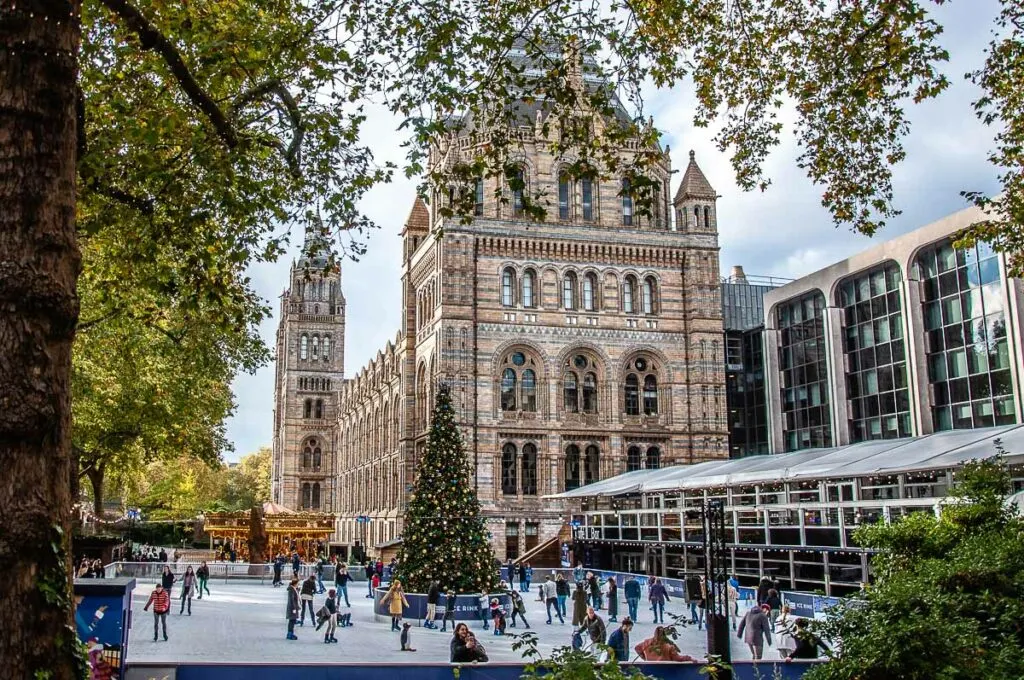
Any season is a good time to visit the three South Kensington Museums in London, England.
In winter, the Natural History Museum hosts one of London’s best ice rinks and one of London’s prettiest Christmas trees. In summer, the John Madejski Garden at the V&A Museum is a wonderful place to sit in and look at the shallow oval pond at its centre and the architecturally stunning buildings of the museum.
However, not every day can be a good day to visit all three of the South Kensington Museums.
At present, the Science Museum and the V&A Museum are generally closed on Monday and Tuesday and open from Wednesday to Sunday. During the school holidays, the Science Museum is open from Monday to Sunday. In principle, the Natural History Museum is always open from Monday to Sunday. The museums are also generally closed on Christmas Eve, Christmas Day, and Boxing Day (24th, 25th, and 26th December).
Before your visit, please, make sure that you check the most up to date opening times of the South Kensington Museums on their official websites: Natural History Museum, Science Museum, and V&A Museum. As mentioned above, booking in advance a free timed entry is the best way to make sure that you will be able to visit the museums on your chosen day and at your chosen time.
Where in London Are the South Kensington Museums?

You will find all three museums in the heart of South Kensington. This is one of Central London’s most upscale districts. It forms part of the Royal Borough of Kensington and Chelsea.
The three museums are officially located on Exhibition Road – a long street named after The Great Exhibition which was held in London in 1851. Their respective buildings, however, are incredibly large. So, the main facade and the main entrance of the Natural History Museum faces the perpendicular Cromwell Road.
The adjacent area is dotted with many monumental buildings and important academic and cultural institutions. Among them are Imperial College London, Royal Albert Hall, Royal Geographical Society, Goethe Institute, RCM Museum of Music, and Japan House London.
Two famous London parks – Hyde Park and Kensington Gardens – are about half a mile away from the three South Kensington Museums. Buckingham Palace is a brisk half-hour or so walk away.
Nearby, there are many lively eateries and restaurants serving food from all over the world. The upscale department store Harrods and the popular for its shopping Kensington High Street are respectively half a mile and a mile away in opposite directions from the South Kensington Museums.
How to Reach the South Kensington Museums in London, England?
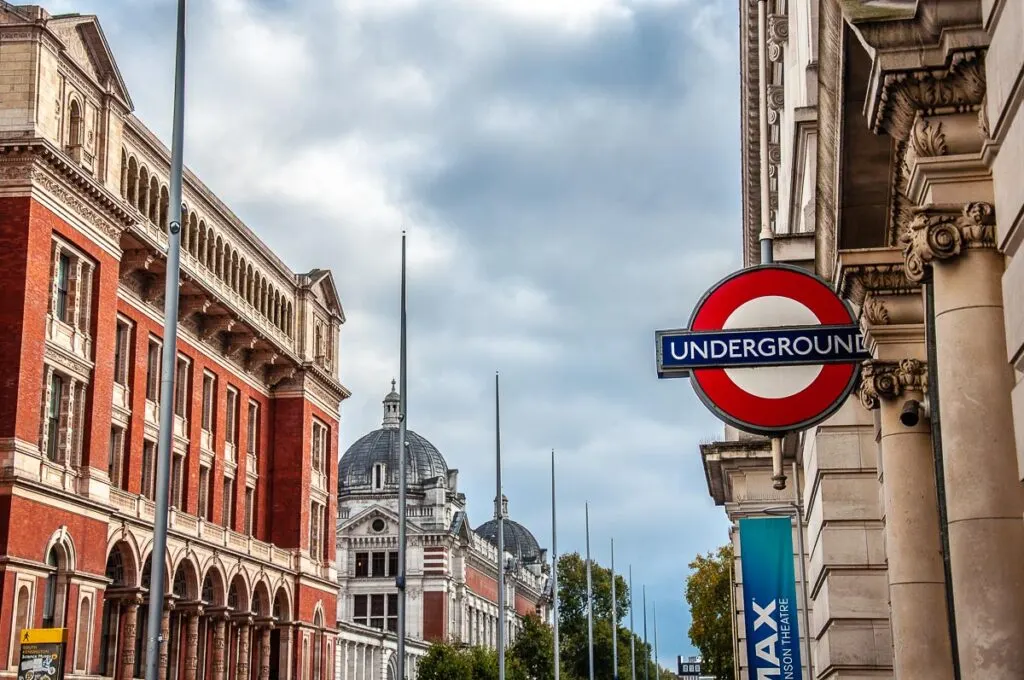
The South Kensington Museums are very easy to reach by public transport from anywhere in London. They are well-connected by tube (as London Underground is traditionally referred to) and bus. You can plan your journey from your specific point of departure to one of the three South Kensington Museums by using the Transport for London website.
South Kensington Underground Station is the nearest tube stop. It is customarily served by three London Underground lines – District, Circle, and Piccadilly. As soon as you arrive, you will see signs at the platform pointing you in the direction of the three museums.
A foot tunnel connects the South Kensington Underground Station to the three museums on Exhibition Road. The tunnel is 447 m long and was built towards the end of the 19th century. Ordinarily, it takes less than five minutes to reach the museums from the tube station following the foot tunnel.
Alternatively, you can travel to Gloucester Road Underground Station, Knightsbridge Underground Station or Kensington High Street Underground Station. Expect walking times of 10 to 25 minutes.
A large number of bus lines serve the area of the South Kensington Museums. For the most up-to-date information about their timetables, route details, first and last services, have a look at this page on the official website of Transport for London.
My Top 5 Practical Tips for Visiting the South Kensington Museums in London, England
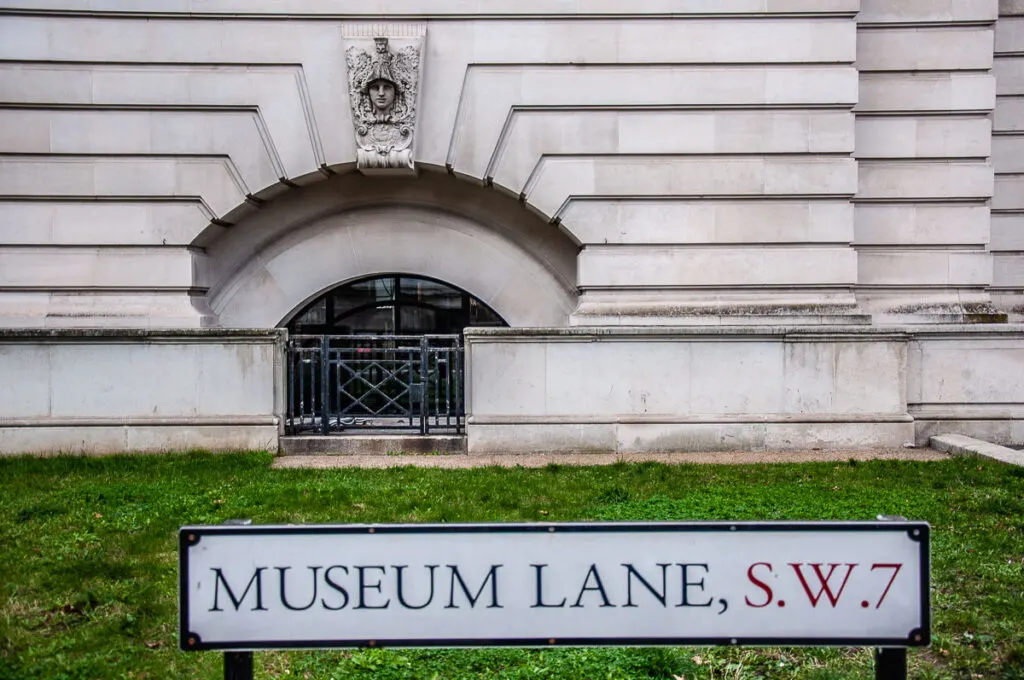
Here are my top five practical tips to help you to better manage the physical effort and the mental stimulation of visiting the South Kensington Museums in London, England:
1. Wear Your Most Comfortable Shoes and Clothes
You will spend the day on your feet, so it really pays to wear something you feel absolutely comfortable in. This is particularly valid if you are visiting the South Kensington Museums with kids.
2. Use the On-Site Cloakrooms
Traipsing around a museum with a heavy bag on your shoulder and a jacket in your hands is torturous (and sweaty!) in itself. Especially, if there is a long day of museum-hopping ahead of you. Luckily, the South Kensington Museums have cloakrooms (although, please, keep in mind that currently, the cloakroom at the V&A Museum is closed).
The downside is that you may need to pay to check in your coat, pushchair, bag or suitcase. While it may feel counterintuitive to pay for something when the museum is otherwise free to access, believe me, your back (and your mood) will be so much better if you don’t have to lug stuff around for hours. And you will enjoy your visit so much more!
To check the current conditions of use and prices for the cloakrooms at the three museums, click on these respective links:
- luggage and cloakroom at the Natural History Museum (scroll under the fold for relevant info);
- cloakroom at the Science Museum (scroll down to the bottom of the page for relevant info); and
- cloakrooms at the V&A Museum (scroll down to the bottom of the page for relevant info). At present, this museum’s cloakrooms are closed.
3. Have a General Idea about What You Want to See
The three South Kensington Museums are large and offer a great variety of exhibits. I have found that having a general idea in advance of what we want to see makes our visits so much better. Although there are only three of us in my family, we all have completely different interests.
Knowing what each one of us would like to see on the day, help us plan things a bit in advance. This way everyone is happy and everyone gets to see something they truly are excited about.
4. Pace Yourself
Visiting museums and museum-hopping can be exhausting. With so much to look at, read about, and absorb, it’s only too easy to get a bit overwhelmed after a couple of hours or so.
The best thing about the South Kensington Museums in London is that they are designed to offer not just constant access to knowledge but also many opportunities for relaxation. There is a wonderful green space around the Natural History Museum and a lovely courtyard with a shallow pool in the V&A Museum. In all three museums, there are lovely cafes and eateries. Not to mention the live harp and piano music in the V&A Café which is also the world’s first museum café.
Taking a moment to sit down, relax, and refuel is also a chance to organise your impressions in your head and to decide on your next destination in the labyrinth of the museums’ collections.
5. Be Flexible
You may head to the South Kensington Museums with very strict ideas about the things you want to see and do in them. That’s fine! Yet, don’t be afraid to change a bit your plans in case something else suddenly sparks your curiosity.
These huge museums pack so much information inside their cavernous buildings, that there is always a new discovery just around the corner. Or right in front of you, for that matter!
So, take every opportunity to learn new things and to even veer off course every now and then! You never know… You might just discover a topic that appeals to you like nothing before.
My Favourite South Kensington Museum…
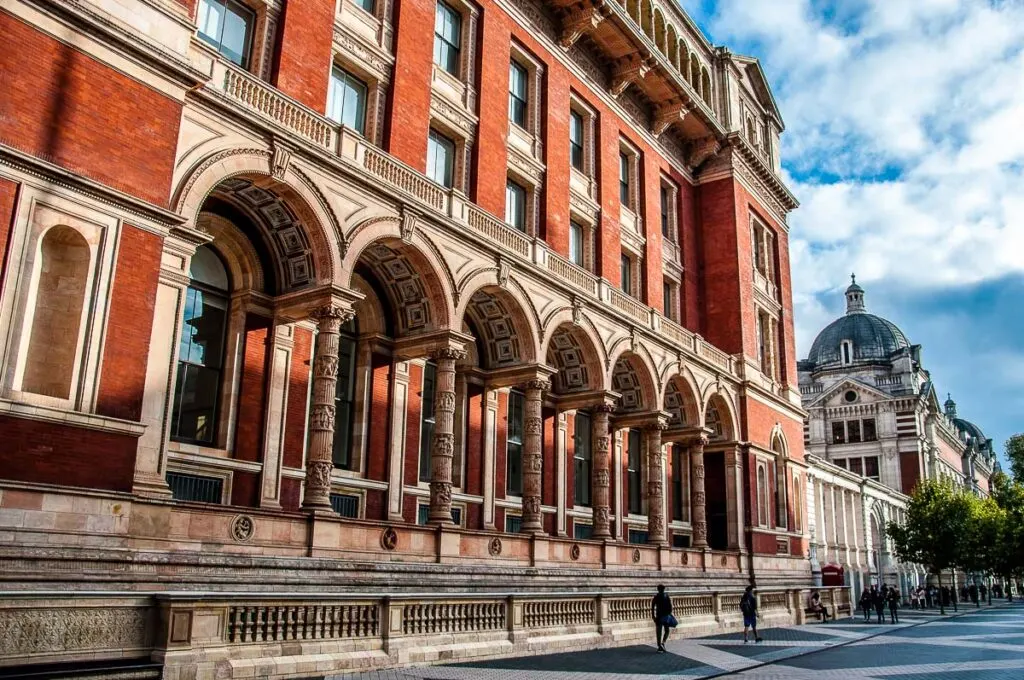
Just in case you are wondering, my favourite South Kensington museum is the V&A Museum. For me, it’s the perfect destination in London on account of my interests in art, the Italian Renaissance, and the International Gothic style. The architecture of its buildings is also very intriguing and a very unique amalgamation of different styles and periods.
I also love the facade of the Natural History Museum. It is really intricate and the more you look, the more details you see. The Hintze Hall – the museum’s cavernous entrance hall – is absolutely stunning. The skeleton of a blue whale – the largest animal on earth – hangs in it. And, as I mentioned above, the Dinosaurs Gallery is great!
As for the Science Museum – I think this is my husband’s favourite one of the three. He is really into science and maths and is very engaging when he talks about them. So, I happily tag along. Also, a few years ago I did a very detailed research about the history of medicine for an article I wrote for the BBC and since then I have a fascination for this field of knowledge which is very well represented in London’s Science Museum.
In any case, the three South Kensington Museums both appeal to different types of interests and inspire you to want to learn more and delve deeper into fields of knowledge and creativity that could be beyond your usual interests. So, visit all of the three museums for yourself and see which one will make you fall in love.
In Conclusion

The South Kensington Museums are three large and worldwide famous museum institutions in the heart of Central London in England. They are the Natural History Museum, the Science Museum, and the V&A Museum. Housed in monumental buildings with stunning architecture and hosting millions of priceless exhibits and artefacts, the three museums are a must-see in the British capital.
With permanent displays and temporary exhibitions covering all fields of human knowledge and creativity, the South Kensington Museums appeal to people of any age and from all walks of life. Visiting them is exciting and stimulating. You get to learn many new things and see some of the world’s most important scientific artefacts and works of art.
In this blog post, I provided you with detailed information about the South Kensington Museums in London, England. From what to see in them to where to find them in the British capital and how to get to them by public transport, there are lots of practical tips and useful details to help you streamline your visit.
I hope that you have found this blog post of use and that before long you will be walking the vast halls and the long galleries of the Natural History Museum, the Science Museum, and the V&A Museum marvelling at their wonderful displays.
Enjoy exploring London!
Now get ready quick for your trip to London in England!
- Consult these guidebooks.
- Book plane tickets to England.
- Book train tickets in England.
- Rent a car in England.
- Research accommodation.
- Pick local tours and activities.
More Helpful England Links for You
Travel in England: Best Towns in England
London: Free Things to Do
Cambridgeshire: Cambridge
Cheshire: Chester
Isle of Wight: Alum Bay, Carisbrooke Castle, Osborne House, Pepperpot, Round the Island Race, St. Catherine’s Lighthouse
Hertfordshire: St. Albans Cathedral
Kent: 10 Reasons to Visit Kent, Kent Life
Northumberland: Lindisfarne
English Lifestyle: Differences Between the English and the Italians, Memorial Benches, Allotments, Charity Shops, Beachtime
English Food: Fish and Chips
Thank you for reading! Please, leave me a comment, pin the images below or use the buttons right at the top and at the end of this blog post to share it on social media.
For more useful information like this, please, like my blog’s page on Facebook and subscribe to my strictly no-spam newsletter.
